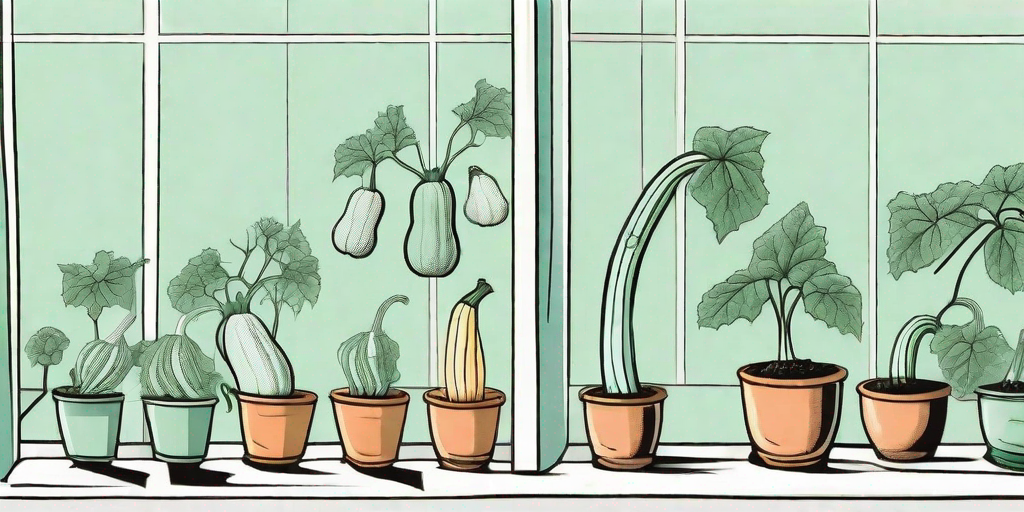
If you've ever thought that growing squash is a task reserved for those with sprawling gardens and acres of land, think again! Even if your outdoor space is limited to a tiny balcony or a small patio, you can still enjoy the thrill of growing your own squash. All you need is a pot, some seeds, and a dash of patience. And maybe a sense of humor, because let's face it, gardening can be a bit of a comedy of errors at times.
Why Grow Squash in Pots?
Before we dive into the how-to, let's take a moment to appreciate the why. Why would anyone want to grow squash in pots? Well, for starters, it's a fantastic way to maximize your space. Squash plants can be quite sprawling, but when grown in pots, they can be trained to grow vertically, saving you precious square footage.
Secondly, growing squash in pots allows you to control the growing conditions more precisely. You can easily move the pots around to ensure they get the optimal amount of sunlight, and you can monitor and adjust the soil conditions as needed. Plus, it's a great conversation starter. Nothing says "I'm a gardening wizard" like a pot full of thriving squash on your balcony.
Choosing the Right Squash for Pot Growing
Not all squash are created equal, especially when it comes to pot growing. Some varieties are better suited to container gardening than others. Generally, compact and bush varieties are your best bet. These include types like 'Honey Bear' acorn squash, 'Bush Delicata', and 'Patio Star' zucchini. These varieties are more compact and less likely to take over your entire outdoor space.
When choosing your squash seeds, also consider what you like to eat. There's no point growing a squash variety that you won't enjoy at the dinner table. Remember, the goal here is from seed to plate, not from seed to compost bin.
Getting Started: What You'll Need
Now that you've chosen your squash variety, it's time to gather your supplies. Here's what you'll need:
- A pot: Choose a large pot with good drainage. Squash plants have large root systems and need plenty of room to grow. A pot that's at least 18 inches in diameter and depth is a good starting point.
- Soil: Use a high-quality potting mix. Squash plants like well-draining soil, so avoid anything too heavy or clay-like.
- Squash seeds: As discussed earlier, choose a variety that's suited to pot growing and one that you'll enjoy eating.
- A trellis or support system: Remember, we're training these plants to grow vertically. A sturdy trellis or support system will help guide the plant upwards and prevent it from sprawling all over your outdoor space.
Planting Your Squash Seeds
With your supplies in hand, it's time to get planting. Fill your pot with the potting mix, leaving about an inch of space at the top. Plant your squash seeds about an inch deep, following the spacing instructions on the seed packet. Generally, you'll want to plant about three seeds per pot.
Once the seeds are planted, water them well and place the pot in a sunny location. Squash plants love the sun, so aim for a spot that gets at least six hours of sunlight per day.
Caring for Your Squash Plants
Now comes the waiting game. While your squash plants are growing, it's important to keep an eye on them and provide the necessary care. This includes regular watering, fertilizing, and pest control.
Water your squash plants regularly, keeping the soil consistently moist but not waterlogged. A good rule of thumb is to water when the top inch of soil feels dry to the touch. As for fertilizing, a balanced vegetable fertilizer applied according to the package instructions should do the trick.
Keep an eye out for common squash pests like squash bugs and cucumber beetles. If you spot any, remove them by hand or use an organic pesticide. Remember, the goal is to grow healthy, edible squash, not to create a bug sanctuary.
Harvesting and Enjoying Your Squash
After all your hard work, the moment of truth arrives: harvest time. The exact time to harvest will depend on the variety of squash you're growing, but generally, you can harvest when the squash is fully colored and the skin is hard.
Once harvested, it's time to enjoy your squash. Whether you're making a hearty squash soup, a savory squash casserole, or simply roasting it with a bit of olive oil and herbs, there's nothing quite like the satisfaction of enjoying a meal made with vegetables you've grown yourself.
Frequently Asked Questions
Can I grow squash indoors?
Yes, you can grow squash indoors, but it can be a bit more challenging. Squash plants need a lot of light, so you'll need to provide supplemental lighting if you don't have a sunny window that gets at least six hours of sunlight per day.
What if my squash plant isn't producing fruit?
If your squash plant is growing but not producing fruit, it could be due to a lack of pollination. Try hand pollinating by using a small paintbrush to transfer pollen from the male flowers to the female flowers.
Can I grow other vegetables in pots?
Absolutely! Many vegetables can be successfully grown in pots. Tomatoes, peppers, cucumbers, and herbs are all great options for container gardening.
So there you have it, the complete guide to growing squash in pots. With a bit of patience, a dash of humor, and the right supplies, you can enjoy the thrill of growing your own squash, no matter how small your outdoor space may be. Happy gardening!











